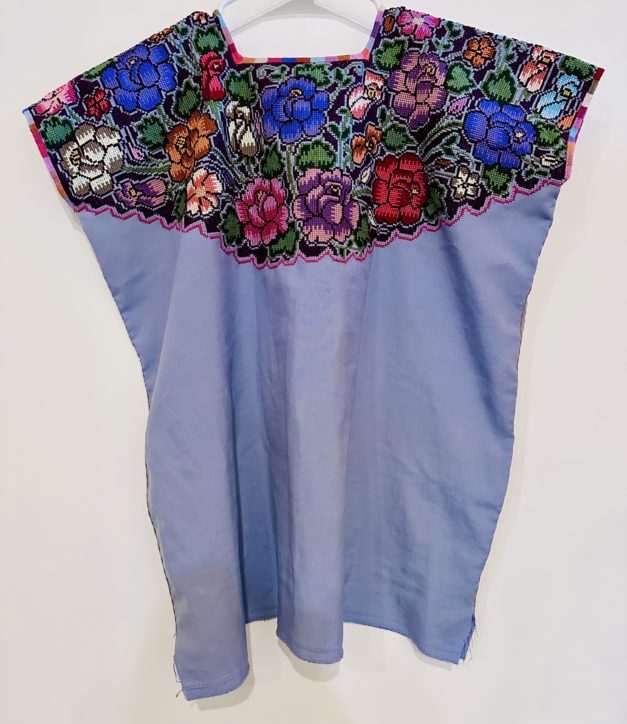We know that New Mexico, in fact the entirety of the southwestern United States, was part of New Spain, and then after Independence in 1821, part of Mexico. The Spanish conquered, enslaved, and imposed Catholicism into all parts of the empire. Christmas celebrations in Oaxaca are an amalgam of pre-Hispanic and Catholic rituals. They are similar here in Taos, New Mexico, where each Christmas Eve, the Taos Pueblo holds a posada against the backdrop of history.

The posada here features a band of men shooting rifles (with blanks). Each crack of gunshot is startling. Following them in procession are others holding flaming logs, pointed skyward, that might be ten feet long. Following them is a covered palanquin (litter) holding the Virgin Mary dressed in white. Locals follow, beating drums, chanting. They are covered in woven serapes or Pendleton blankets wrapped tightly around their shoulders. It is cold this time of year in Northern New Mexico. The children have shell ankle bracelets that jingle when they move.


At first glance, one might assume that this is the ritual of Catholicism worldwide — the Christmas posada, or procession, depicting Mary and Joseph seeking shelter where she can give birth to Jesus. Here, too, the Virgin is dressed in white and carried in a palanquin. I have experienced this so many times in Teotitlan del Valle, where the posadas continue for nine nights, from December 16 to December 24. La Ultima Posada, on Christmas Eve, is the final procession to find the manger where Baby Jesus is born. In Teotitlan, the host family offers an elaborate celebration complete with all night feasting.


But, it is different in Taos pueblo. Christmas Eve, the men carrying rifles, and the attending bonfires are a re-enactment of a painful memory — the 1680 Pueblo Revolt, when the Spanish military entered the village. Many of the pueblo inhabitants — women, children, men, elderly and infants — sought shelter in the church, believing that they would not be harmed there. The Spanish burned the church, killing all inside. The ancient adobe bell tower is all that remains, a reminder of this oppressive history.


In this re-enactment, I see the men shooting rifles symbolizing the Spanish invaders. I believe the burning wood stanchions are a reminder of the destruction of the church. And, I interpret the burning 25-30 foot high pyres to represent the church as it burned to the ground. Those who have not read the history, come to visit for the spectacle. And, indeed, it is that!



On a cold Christmas Eve in Taos, New Mexico, the burning wood towers keep us warm as we huddle together in the 20 degree Fahrenheit evening chill, remembering, honoring those who stood here before us.
This is the day that darkness begins to turn toward light. May this holiday season and your new year be light-filled, with good health, cheer, contentment, and peace. Thank you for reading.

























Around the Zocalo, Sunday in Mexico City
I love to stay in the historic center of Mexico City to walk the cobbled streets, take in the murals and enjoy the street life. There is a deep sense of ancient history here reflecting Aztec roots. The Templo Mayor is nearby with an impressive archeological dig going on to uncover more of Tenochtitlan.
For art glass lovers, two buildings boast art nouveau glass domed ceilings. The central atrium of the upscale department store Palacio de Hierro has a fine example. The other adorns the Gran Hotel Ciudad de Mexico. The hotel is at the corner of the Zocalo (entrance on Av. 16 de Septiembre) and the store is a block away.
On this particular Sunday, the last before Easter vacation ends and Mexican school children must return to the classroom, we are approached by youngsters needing to complete their school assignments: interview a foreigner who speaks English and record the interview. It is almost dusk. Time is running out. Parents are at hand with tablets and hand-held devices to help get this done.
We finish off the Zocalo stroll at the rooftop restaurant of Gran Hotel Ciudad de Mexico with a mango mezcal margarita rimmed with worm salt and a magnificent Zocalo view as the sun sets.
Then, it’s off to Calle Isabel la Catolica #30 for a grand finale dinner at Azul Historico.
Be sure to catch the indigenous clothing gallery, Remigio, on the second floor of Isabel la Catolica #30 featuring hand-woven garments with natural dyes. Right next door, avant clothing designer Carla Fernandez offers hand-carved wood bracelets from molinillo parts. Both shops close at 6 p.m. on Sunday, 8 p.m. other nights.
In the same building, behind the central stairway, is a mural by artist Manuel Rodriguez Lozano called the Holocaust — not to be missed!
Lots to do in just a few square blocks.
Some of the highlights of our Looking for Diego Rivera and Frida Kahlo Art History Tour of Mexico City. Contact me if you want to join in winter/spring 2015-2016.
Like this:
2 Comments
Posted in Cultural Commentary, Mexico City, Photography, Travel & Tourism, Workshops and Retreats
Tagged art glass, art history, art nouveau, Aztecs, Diego Rivera, Frida Kahlo, Lozano, Mexico City, Spanish conquest, Templo Mayor, Tenochtitlan, tour, travel, workshop, Zocalo